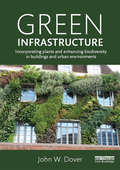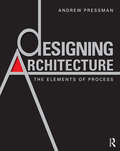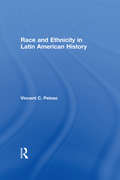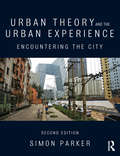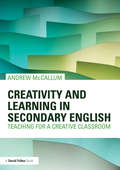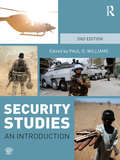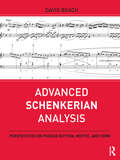- Table View
- List View
Governing Metropolitan Areas: Growth and Change in a Networked Age
by David K. HamiltonInterest and research on regionalism has soared in the last decade. Local governments in metropolitan areas and civic organizations are increasingly engaged in cooperative and collaborative public policy efforts to solve problems that stretch across urban centers and their surrounding suburbs. Yet there remains scant attention in textbooks to the issues that arise in trying to address metropolitan governance. Governing Metropolitan Areas describes and analyzes structure to understand the how and why of regionalism in our global age. The book covers governmental institutions and their evolution to governance, but with a continual focus on institutions. David Hamilton provides the necessary comprehensive, in-depth description and analysis of how metropolitan areas and governments within metropolitan areas developed, efforts to restructure and combine local governments, and governance within the polycentric urban region.This second edition is a major revision to update the scholarship and current thinking on regional governance. While the text still provides background on the historical development and growth of urban areas and governments' efforts to accommodate the growth of metropolitan areas, this edition also focuses on current efforts to provide governance through cooperative and collaborative solutions. There is also now extended treatment of how regional governance outside the United States has evolved and how other countries are approaching regional governance.
Green Infrastructure: Incorporating Plants and Enhancing Biodiversity in Buildings and Urban Environments (Routledge Studies in Urban Ecology)
by John W. DoverWith more than half of the world's population now living in urban areas, it is vitally important that towns and cities are healthy places to live. The principal aim of this book is to synthesize the disparate literature on the use of vegetation in the built environment and its multifunctional benefits to humans. The author reviews issues such as: contact with wildlife and its immediate and long-term effects on psychological and physical wellbeing; the role of vegetation in removing health-damaging pollutants from the air; green roofs and green walls, which provide insulation, reduce energy use and decrease the carbon footprint of buildings; and structural vegetation such as street trees, providing shading and air circulation whilst also helping to stop flash-floods through surface drainage. Examples are used throughout to illustrate the practical use of vegetation to improve the urban environment and deliver ecosystem services. Whilst the underlying theme is the value of biodiversity, the emphasis is less on existing high-value green spaces (such as nature reserves, parks and gardens), than on the sealed surfaces of urban areas (building surfaces, roads, car parks, plazas, etc.). The book shows how these, and the spaces they encapsulate, can be modified to meet current and future environmental challenges including climate change. The value of existing green space is also covered to provide a comprehensive textbook of international relevance.
The Feeling Child: Laying the foundations of confidence and resilience
by Maria RobinsonWhat impact does children’s emotional development and well-being have on their capacity to learn? How do you provide learning experiences that meet the developmental needs of every child in your care? The Feeling Child thoughtfully discusses the key principles of children’s emotional and behavioural development alongside descriptions of everyday practice. It clearly explains how a child’s early experiences influence their particular behaviours towards different people and different situations. Throughout the book, Maria Robinson considers the key characteristics of effective learning and shows how play is one of the key mechanisms that children use in their discovery of themselves and the world around them. These characteristics are then applied to integral aspects of early years practice to help practitioners to: support children to come to new understandings in safe yet challenging ways understand the ways in which children may approach or withdraw from learning opportunities reflect on their own teaching methods to encourage children’s engagement, motivation and creativity through effective observation and planning engage with parents and carers to help support children’s learning at home whilst maintaining the values of the family. celebrate the uniqueness of each child and provide learning experiences that are appropriate for individuals with particular learning needs, be they physical, emotional or cognitive to ensure that every child has an equal opportunity to succeed. Emphasising the importance of understanding the theory that underpins children’s emotional development, this accessible text shows practitioners how they can use this knowledge to provide learning opportunities that nourish children’s thinking and creative skills.
The Feeling Child: Laying the foundations of confidence and resilience
by Maria RobinsonWhat impact does children’s emotional development and well-being have on their capacity to learn? How do you provide learning experiences that meet the developmental needs of every child in your care? The Feeling Child thoughtfully discusses the key principles of children’s emotional and behavioural development alongside descriptions of everyday practice. It clearly explains how a child’s early experiences influence their particular behaviours towards different people and different situations. Throughout the book, Maria Robinson considers the key characteristics of effective learning and shows how play is one of the key mechanisms that children use in their discovery of themselves and the world around them. These characteristics are then applied to integral aspects of early years practice to help practitioners to: support children to come to new understandings in safe yet challenging ways understand the ways in which children may approach or withdraw from learning opportunities reflect on their own teaching methods to encourage children’s engagement, motivation and creativity through effective observation and planning engage with parents and carers to help support children’s learning at home whilst maintaining the values of the family. celebrate the uniqueness of each child and provide learning experiences that are appropriate for individuals with particular learning needs, be they physical, emotional or cognitive to ensure that every child has an equal opportunity to succeed. Emphasising the importance of understanding the theory that underpins children’s emotional development, this accessible text shows practitioners how they can use this knowledge to provide learning opportunities that nourish children’s thinking and creative skills.
Designing Architecture: The Elements of Process
by Andrew PressmanDesigning Architecture is an indispensable tool to assist both students and young architects in formulating an idea, transforming it into a building, and making effective design decisions. This book promotes integrative and critical thinking in the preliminary design of buildings to inspire creativity, innovation, and design excellence. This compendium of individual wisdom and collective experience offers explicit guidance to students and young professionals on how to approach, analyze, and execute specific tasks; develop and refine a process to facilitate the best possible design projects; and create meaningful architectural form. Here the design process – from orchestrating client participation to finalizing schematic design – is explored and illuminated. The following material is presented to make the book a useful didactic tool for professional development: explicit strategies for doing design rather than simply reviewing principles and precedents creative ideas in approaching and framing problems in design terms specific methods to translate ideas to culturally significant, socially responsive, and environmentally sensitive buildings techniques to integrate all levels of cognition from analysis to epiphany counsel on developing a personalized process for engaging design projects case studies augment the text and chronicle fascinating applications of the design process. The essence of this book lies in an integrated and holistic approach to each unique project as well as fostering curiosity and exploration – a departure from algorithms, easy generalities, or a formula for design. Designing Architecture will inspire readers to elevate the quality of preliminary designs and unravel some of the mystery of creating the most beautiful, responsive, and responsible architectural design possible.
Race and Ethnicity in Latin American History
by Vincent PelosoThe Spanish and Portuguese empires that existed in the Americas for over three hundred years resulted in the creation of a New World population in which a complex array of racial and ethnic distinctions were embedded in the discourse of power. During the colonial era, racial and ethnic identities were publicly acknowledged by the state and the Church, and subject to stringent codes that shaped both individual lives and the structures of society. The legacy of these distinctions continued after independence, as race and ethnicity continued to form culturally defined categories of social life. In Race and Ethnicity in Latin American History, Vincent Peloso traces the story of ethnicity and race in Latin America from the sixteenth century to the contemporary period. In a short, synthetic narrative, he lays the groundwork for students to understand how the history of colonial racism is connected to the problems of racism in today’s Latin American societies. With features including timelines, plentiful maps and illustrations, and boxes highlighting important historical figures, the text provides a clear and accessible introduction to the complex subject of race and ethnicity in the history of Latin America.
Race and Ethnicity in Latin American History
by Vincent PelosoThe Spanish and Portuguese empires that existed in the Americas for over three hundred years resulted in the creation of a New World population in which a complex array of racial and ethnic distinctions were embedded in the discourse of power. During the colonial era, racial and ethnic identities were publicly acknowledged by the state and the Church, and subject to stringent codes that shaped both individual lives and the structures of society. The legacy of these distinctions continued after independence, as race and ethnicity continued to form culturally defined categories of social life. In Race and Ethnicity in Latin American History, Vincent Peloso traces the story of ethnicity and race in Latin America from the sixteenth century to the contemporary period. In a short, synthetic narrative, he lays the groundwork for students to understand how the history of colonial racism is connected to the problems of racism in today’s Latin American societies. With features including timelines, plentiful maps and illustrations, and boxes highlighting important historical figures, the text provides a clear and accessible introduction to the complex subject of race and ethnicity in the history of Latin America.
Gender and Justice: Why Women in the Judiciary Really Matter
by Sally J. KenneyIntended for use in courses on law and society, as well as courses in women’s and gender studies, women and politics, and women and the law, this book explores different questions in different North American and European geographical jurisdictions and courts, demonstrating the value of a gender analysis of courts, judges, law, institutions, organizations, and, ultimately, politics. Gender and Justice argues empirically for both more women and more feminists on the bench, while demonstrating that achieving these two aims are independent projects.
Gender and Justice: Why Women in the Judiciary Really Matter
by Sally J. KenneyIntended for use in courses on law and society, as well as courses in women’s and gender studies, women and politics, and women and the law, this book explores different questions in different North American and European geographical jurisdictions and courts, demonstrating the value of a gender analysis of courts, judges, law, institutions, organizations, and, ultimately, politics. Gender and Justice argues empirically for both more women and more feminists on the bench, while demonstrating that achieving these two aims are independent projects.
Urban Theory and the Urban Experience: Encountering the City
by Simon ParkerUrban Theory and the Urban Experience brings together classic and contemporary approaches to urban research in order to reveal the intellectual origins of urban studies and the often unacknowledged debt that empirical and theoretical perspectives on the city owe one another. From the foundations of modern urban theory in the work of Weber, Simmel, Benjamin and Lefebbvre to the writings of contemporary urban theorists such as David Harvey and Manuel Castells and the Los Angeles school of urbanism, Urban Theory and the Urban Experience traces the key developments in the idea of the city over more than a century. Individual chapters explore investigative studies of the great metropolis from Charles Booth to the contemporary urban research of William J. Wilson, along with alternative approaches to the industrial city, ranging from the Garden City Movement to ‘the new urbanism’. The volume also considers the impact of new information and communication technologies, and the growing trend towards disaggregated urban networks, all of which raise important questions about viability and physical and social identity of the conventional townscape. Urban Theory and the Urban Experience concludes with a rallying cry for a more holistic and integrated approach to the urban question in theory and in practice if the rich potent. For the benefit of students and tutors, frequent question points encourage exploration of key themes, and annotated further readings provide follow-up sources for the issues raised in each chapter. The book will be of interest to students, scholars, practitioners and all those who wish to learn more about why the urban has become the dominant social, economic and cultural form of the twenty-first century
White Party, White Government: Race, Class, and U.S. Politics
by Joe R. FeaginWhite Party, White Government examines the centuries-old impact of systemic racism on the U.S. political system. The text assesses the development by elite and other whites of a racialized capitalistic system, grounded early in slavery and land theft, and its intertwining with a distinctive political system whose fundamentals were laid down in the founding decades. From these years through the Civil War and Reconstruction, to the 1920s, the 1930s Roosevelt era, the 1960s Johnson era, through to the Ronald Reagan, George H.W. Bush, and Barack Obama presidencies, Feagin exploring the effects of ongoing demographic changes on the present and future of the U.S. political system.
White Party, White Government: Race, Class, and U.S. Politics
by Joe R. FeaginWhite Party, White Government examines the centuries-old impact of systemic racism on the U.S. political system. The text assesses the development by elite and other whites of a racialized capitalistic system, grounded early in slavery and land theft, and its intertwining with a distinctive political system whose fundamentals were laid down in the founding decades. From these years through the Civil War and Reconstruction, to the 1920s, the 1930s Roosevelt era, the 1960s Johnson era, through to the Ronald Reagan, George H.W. Bush, and Barack Obama presidencies, Feagin exploring the effects of ongoing demographic changes on the present and future of the U.S. political system.
The American Elections of 2012
by Janet M. Box-Steffensmeier Steven E. SchierThe 2012 American elections were highly competitive, with the unusually close partisan balance making the elections an opportunity for each of the two major parties. This book assembles leading political scientists and political journalists to explain the 2012 election results and their implications for America’s future. In addition to assessing election results, the book examines the consequences of the large ambitions of the Obama presidency and the political and policy risks entailed in the pursuit of those ambitions. It also explores Congressional elections and policymaking since 2008, and how they affected election results in 2012. The book promises a more coherent focus than that evident in similar edited works, achieved through a limited number of chapters and clear definition of chapter content.
The American Elections of 2012
by Janet M. Box-Steffensmeier Steven E. SchierThe 2012 American elections were highly competitive, with the unusually close partisan balance making the elections an opportunity for each of the two major parties. This book assembles leading political scientists and political journalists to explain the 2012 election results and their implications for America’s future. In addition to assessing election results, the book examines the consequences of the large ambitions of the Obama presidency and the political and policy risks entailed in the pursuit of those ambitions. It also explores Congressional elections and policymaking since 2008, and how they affected election results in 2012. The book promises a more coherent focus than that evident in similar edited works, achieved through a limited number of chapters and clear definition of chapter content.
Creativity and Learning in Secondary English: Teaching for a creative classroom
by Andrew McCallumCreativity in secondary English lessons today is a democratically conceived quality that all pupils are expected to achieve and a resource on which all are entitled to draw. But what exactly is creativity? And how does it relate to English? Creativity and Learning in Secondary English answers these questions, and others, by arguing for a version of creativity that sees it as an ordinary, everyday part of successful classroom practice, central to processes of meaning-making, dialogic interaction and textual engagement. In this construction, creativity is not just linked to learning; it is the driving force behind learning itself, offering pupils the opportunity to transform their knowledge and understanding of the world around them. This book borrows from a range of theories about creativity and about learning, while remaining largely practical in focus. It contains numerous examples for teachers of how to apply ideas about creativity in the classroom. In doing so, it attempts to maintain the subject’s core identity while also keeping abreast of contemporary social, pedagogical and technological developments. The result is a refreshing challenge to some of the more mundane approaches to English teaching on offer in an age focussed excessively on standardisation and teaching to tests. Practical applications of creativity include: Using picture books and graphic novels to stimulate multimodal responses Placing pupils in the role of the teacher Devising marketing campaigns for class novels Adopting experimental approaches to redrafting Encouraging ‘extreme’ forms of re-creative writing Focusing on how to ‘listen’ to texts Creating sound-scapes for poems Thought-provoking and provocative, this textbook draws on current best practice in English teaching and will equip trainee and practising teachers with a wide range of strategies that will lead to greater creativity in the classroom.
Creativity and Learning in Secondary English: Teaching for a creative classroom
by Andrew McCallumCreativity in secondary English lessons today is a democratically conceived quality that all pupils are expected to achieve and a resource on which all are entitled to draw. But what exactly is creativity? And how does it relate to English? Creativity and Learning in Secondary English answers these questions, and others, by arguing for a version of creativity that sees it as an ordinary, everyday part of successful classroom practice, central to processes of meaning-making, dialogic interaction and textual engagement. In this construction, creativity is not just linked to learning; it is the driving force behind learning itself, offering pupils the opportunity to transform their knowledge and understanding of the world around them. This book borrows from a range of theories about creativity and about learning, while remaining largely practical in focus. It contains numerous examples for teachers of how to apply ideas about creativity in the classroom. In doing so, it attempts to maintain the subject’s core identity while also keeping abreast of contemporary social, pedagogical and technological developments. The result is a refreshing challenge to some of the more mundane approaches to English teaching on offer in an age focussed excessively on standardisation and teaching to tests. Practical applications of creativity include: Using picture books and graphic novels to stimulate multimodal responses Placing pupils in the role of the teacher Devising marketing campaigns for class novels Adopting experimental approaches to redrafting Encouraging ‘extreme’ forms of re-creative writing Focusing on how to ‘listen’ to texts Creating sound-scapes for poems Thought-provoking and provocative, this textbook draws on current best practice in English teaching and will equip trainee and practising teachers with a wide range of strategies that will lead to greater creativity in the classroom.
Security Studies: An Introduction
by Paul D. WilliamsSecurity Studies is the most comprehensive textbook available on security studies. Comprehensively revised for the new edition including new chapters on Polarity, Culture, Intelligence, and the Academic and Policy Worlds, it continues to give students a detailed overview of the major theoretical approaches, key themes and most significant issues within security studies. Part 1 explores the main theoretical approaches currently used within the field from realism to international political sociology. Part 2 explains the central concepts underpinning contemporary debates from the security dilemma to terrorism. Part 3 presents an overview of the institutional security architecture currently influencing world politics using international, regional and global levels of analysis. Part 4 examines some of the key contemporary challenges to global security from the arms trade to energy security. Part 5 discusses the future of security. Security Studies provides a valuable teaching tool for undergraduates and MA students by collecting these related strands of the field together into a single coherent textbook. Contributors:Richard J. Aldrich, Deborah D. Avant, Sita Bali, Michael N. Barnett, Alex J. Bellamy, Didier Bigo, Pinar Bilgin, Ken Booth, Barry Buzan, Stuart Croft, Simon Dalby, John S. Duffield, Colin Elman, Louise Fawcett, Lawrence Freedman, James M. Goldgeier, Fen Osler Hampson, William D. Hartung, Michael Jensen, Adam Jones, Danielle Zach Kalbacher, Stuart J. Kaufman, Michael T. Klare, Peter Lawler, Matt McDonald, Colin McInnes, Cornelia Navari, Michael Pugh, Paul R. Pillar, Srinath Raghavan, Paul Rogers, Waheguru Pal Singh Sidhu, Joanna Spear, Caroline Thomas,?Thomas G. Weiss, Nicholas J. Wheeler, Sandra Whitworth, Paul D. Williams, Phil Williams and Frank C. Zagare.
Security Studies: An Introduction
by Paul D. WilliamsSecurity Studies is the most comprehensive textbook available on security studies. Comprehensively revised for the new edition including new chapters on Polarity, Culture, Intelligence, and the Academic and Policy Worlds, it continues to give students a detailed overview of the major theoretical approaches, key themes and most significant issues within security studies. Part 1 explores the main theoretical approaches currently used within the field from realism to international political sociology. Part 2 explains the central concepts underpinning contemporary debates from the security dilemma to terrorism. Part 3 presents an overview of the institutional security architecture currently influencing world politics using international, regional and global levels of analysis. Part 4 examines some of the key contemporary challenges to global security from the arms trade to energy security. Part 5 discusses the future of security. Security Studies provides a valuable teaching tool for undergraduates and MA students by collecting these related strands of the field together into a single coherent textbook. Contributors:Richard J. Aldrich, Deborah D. Avant, Sita Bali, Michael N. Barnett, Alex J. Bellamy, Didier Bigo, Pinar Bilgin, Ken Booth, Barry Buzan, Stuart Croft, Simon Dalby, John S. Duffield, Colin Elman, Louise Fawcett, Lawrence Freedman, James M. Goldgeier, Fen Osler Hampson, William D. Hartung, Michael Jensen, Adam Jones, Danielle Zach Kalbacher, Stuart J. Kaufman, Michael T. Klare, Peter Lawler, Matt McDonald, Colin McInnes, Cornelia Navari, Michael Pugh, Paul R. Pillar, Srinath Raghavan, Paul Rogers, Waheguru Pal Singh Sidhu, Joanna Spear, Caroline Thomas,?Thomas G. Weiss, Nicholas J. Wheeler, Sandra Whitworth, Paul D. Williams, Phil Williams and Frank C. Zagare.
Digital Drama: Teaching and Learning Art and Media in Tanzania
by Paula UimonenThe aim of this book is to explore digital media and intercultural interaction at an arts college in Tanzania, through innovative forms of ethnographic representation. The book and the series website weave together visual and aural narratives, interviews and observations, life stories and video documentaries, art performances and productions. It paints a vivid portrayal of everyday life in East Africa’s only institute for practical art training, while tracing the rich cultural history of a state that has mixed tribalism, nationalism, Pan-Africanism, and cosmopolitanism in astonishingly creative ways. While following the anthropological tradition of thick description, Digital Drama employs a more artistic and accessible style of writing. Dramatic, ethnographic details are interspersed with theoretical reflections and postulations to explain and make sense of the unfolding narratives. The accompanying website visualizes and sensualizes the stories narrated in the book, unfolding a dramatic world of African dance, music, theater, and digital culture.
Digital Drama: Teaching and Learning Art and Media in Tanzania
by Paula UimonenThe aim of this book is to explore digital media and intercultural interaction at an arts college in Tanzania, through innovative forms of ethnographic representation. The book and the series website weave together visual and aural narratives, interviews and observations, life stories and video documentaries, art performances and productions. It paints a vivid portrayal of everyday life in East Africa’s only institute for practical art training, while tracing the rich cultural history of a state that has mixed tribalism, nationalism, Pan-Africanism, and cosmopolitanism in astonishingly creative ways. While following the anthropological tradition of thick description, Digital Drama employs a more artistic and accessible style of writing. Dramatic, ethnographic details are interspersed with theoretical reflections and postulations to explain and make sense of the unfolding narratives. The accompanying website visualizes and sensualizes the stories narrated in the book, unfolding a dramatic world of African dance, music, theater, and digital culture.
Advanced Schenkerian Analysis: Perspectives on Phrase Rhythm, Motive, and Form
by David BeachAdvanced Schenkerian Analysis: Perspectives on Phrase Rhythm, Motive, and Form is a textbook for students with some background in Schenkerian theory. It begins with an overview of Schenker's theories, then progresses systematically from the phrase and their various combinations to longer and more complex works. Unlike other texts on this subject, Advanced Schenkerian Analysis combines the study of multi-level pitch organization with that of phrase rhythm (the interaction of phrase and hypermeter), motivic repetition at different structural levels, and form. It also contains analytic graphs of several extended movements, separate works, and songs. A separate Instructor’s Manual provides additional advice and solutions (graphs) of all recommended assignments.
Advanced Schenkerian Analysis: Perspectives on Phrase Rhythm, Motive, and Form
by David BeachAdvanced Schenkerian Analysis: Perspectives on Phrase Rhythm, Motive, and Form is a textbook for students with some background in Schenkerian theory. It begins with an overview of Schenker's theories, then progresses systematically from the phrase and their various combinations to longer and more complex works. Unlike other texts on this subject, Advanced Schenkerian Analysis combines the study of multi-level pitch organization with that of phrase rhythm (the interaction of phrase and hypermeter), motivic repetition at different structural levels, and form. It also contains analytic graphs of several extended movements, separate works, and songs. A separate Instructor’s Manual provides additional advice and solutions (graphs) of all recommended assignments.
Global Entertainment Media: Between Cultural Imperialism and Cultural Globalization
by Tanner MirrleesA critical cultural materialist introduction to the study of global entertainment media. In Global Entertainment Media, Tanner Mirrlees undertakes an analysis of the ownership, production, distribution, marketing, exhibition and consumption of global films and television shows, with an eye to political economy and cultural studies. Among other topics, Mirrlees examines: Paradigms of global entertainment media such as cultural imperialism and cultural globalization. The business of entertainment media: the structure of capitalist culture/creative industries (financers, producers, distributors and exhibitors) and trends in the global political economy of entertainment media. The "governance" of global entertainment media: state and inter-state media and cultural policies and regulations that govern the production, distribution and exhibition of entertainment media and enable or impede its cross-border flow. The new international division of cultural labor (NICL): the cross-border production of entertainment by cultural workers in asymmetrically interdependent media capitals, and economic and cultural concerns surrounding runaway productions and co-productions. The economic motivations and textual design features of globally popular entertainment forms such as blockbuster event films, TV formats, glocalized lifestyle brands and synergistic media. The cross-cultural reception and effects of TV shows and films. The World Wide Web, digitization and convergence culture.
Global Entertainment Media: Between Cultural Imperialism and Cultural Globalization
by Tanner MirrleesA critical cultural materialist introduction to the study of global entertainment media. In Global Entertainment Media, Tanner Mirrlees undertakes an analysis of the ownership, production, distribution, marketing, exhibition and consumption of global films and television shows, with an eye to political economy and cultural studies. Among other topics, Mirrlees examines: Paradigms of global entertainment media such as cultural imperialism and cultural globalization. The business of entertainment media: the structure of capitalist culture/creative industries (financers, producers, distributors and exhibitors) and trends in the global political economy of entertainment media. The "governance" of global entertainment media: state and inter-state media and cultural policies and regulations that govern the production, distribution and exhibition of entertainment media and enable or impede its cross-border flow. The new international division of cultural labor (NICL): the cross-border production of entertainment by cultural workers in asymmetrically interdependent media capitals, and economic and cultural concerns surrounding runaway productions and co-productions. The economic motivations and textual design features of globally popular entertainment forms such as blockbuster event films, TV formats, glocalized lifestyle brands and synergistic media. The cross-cultural reception and effects of TV shows and films. The World Wide Web, digitization and convergence culture.
How to be a Brilliant FE Teacher: A practical guide to being effective and innovative
by Vicky DuckworthHow to be a Brilliant FE Teacher is a straightforward, friendly guide to being an effective and innovative teacher in post-compulsory education. Focussing on practical advice drawn from the author’s extensive and successful personal experience of both teaching and training teachers, it offers sound guidance, underpinned by the latest research, theory and policy in the field. Structured around the questions that all new teachers and lecturers ask in their first teaching post, it is an introduction to both essential teaching skills and what to expect from working in this exciting, fast-paced sector. Key chapters cover: The learners – who they are, diversity and motivation; What will actually happen – organising teaching, technology and resources; How to keep your students’ interest – understanding and responding to learning styles; How will I know if they’ve learned it? – assessment and feedback; Making sure it’s working – student evaluation, reflecting on and improving practice. Packed throughout with information about where to find the best materials and resources to support your teaching, this book also offers sensible advice on balancing home and life, working effectively with your colleagues and progressing in your career. How to be a Brilliant FE Teacher will be a source of support and inspiration for all those embarking on their initial training and first post in the sector, as well as qualified professionals looking for reassuring, fresh ideas.

